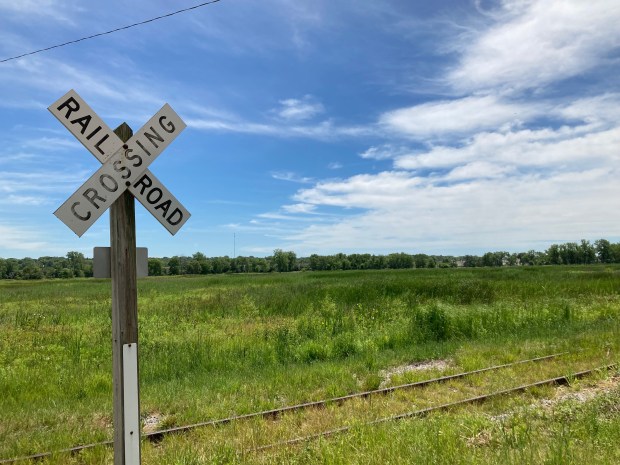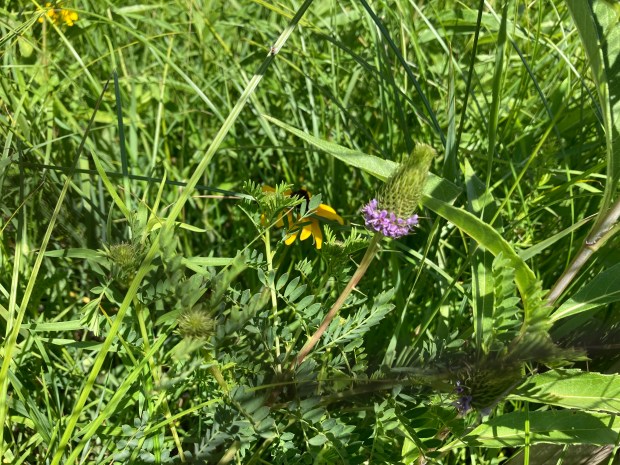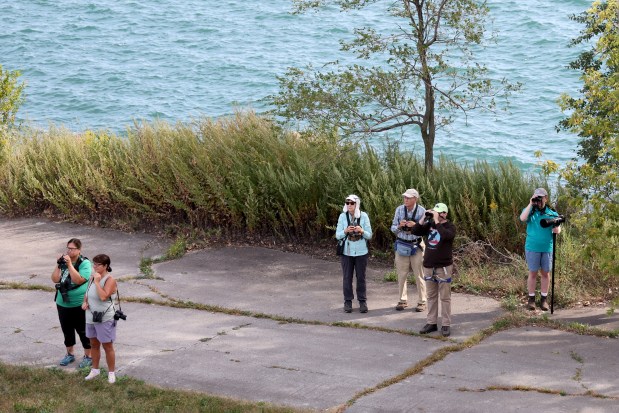The strip of land sandwiched between the Sanitary and Ship Canal and Illinois 53 just west of Lockport never was good for much.
For a while, cattle owned by Stateville Prison across the street grazed on the grass and clover that had found purchase in the thin topsoil at the bottom of the bluff, but crops couldn’t grow there, and river water often turned the little dirt that was there into squishy mud.
In truth, the shallow bedrock sheltered an ecosystem now considered globally rare, but for a long time, it’s likely nobody would have cared.
Just across the river, the wheels of commerce were rolling early. Lockport was established in 1837 as the headquarters of the Illinois & Michigan Canal, where officials directed the construction of the first waterway linking the Great Lakes and the Mississippi River system, putting Chicago on the world map. Business was booming.
A larger canal eventually superseded the I&M, and Lockport’s fortunes ebbed and flowed over the decades, becoming a Chicago suburb and attracting the usual suburban accouterments of development. Only the spit of unusable land southeast of the busy corner of Illinois Routes 7 and 53 remained largely untouched until the early 1970s, when it was eyed as a dump site.
Instead, federal officials joined representatives from Will County six years ago to announce millions of dollars would be poured into the property.
Long owned by the Metropolitan Water Reclamation District of Greater Chicago, administrator of the adjacent Chicago Sanitary and Ship Canal that reversed the Chicago River at the turn of the 20th Century, the land, now called Lockport Prairie Nature Preserve, was acquired by the Forest Preserve District of Will County in 2015.
And May 31, county, state and federal officials gathered at the site to cut a ceremonial ribbon for Lockport Prairie and nearby Prairie Bluff preserves, where the 6-year, $8.3 million “major ecosystem restoration project” had just wrapped up, marking the completion of a plan that had been in discussions since the 1990s. The Army Corps of Engineers invested $5.5 million in federal aquatic ecosystem restoration funds, while the Forest Preserve District contributed $2.8 million in land value, according to a Will County news release.
That money went toward removal of invasive species and restoration of natural underground flow processes from Prairie Bluff down to Lockport Prairie, home to two plant species and a dragonfly listed as federally endangered, as well as several others deemed rare and at risk.
“It’s a really high-quality remnant,” said Julianne Mason, a botanist and project manager with the Forest Preserve District. “Both why it’s special and why it got spared are two in the same. The shallow soils over dolomite bedrock weren’t farmable or usable in a lot of the normal ways.”
The Army Corps first took notice of the property in 1971, when it was under consideration as a dumping ground for spoil material as part of potential work on a new lock and channel along the Sanitary and Ship Canal at Lockport. The Army enlisted biologists Floyd Swink and Ray Schulenberg from the Morton Arboretum to assist one of their own, Gerould Wilhelm, as they considered sites to despoil.
Most of the 50 sites under consideration were full of weeds and of little natural value, Wilhelm recounted in an essay printed in the 2017 botanical tome “Flora of the Chicago Region.” No matter what the corps did at the sites, the plants would grow back. That wasn’t the case at “Spoil Site L2” at the end of Division Street in Lockport, which Wilhelm visited with Schulenberg.
“Don’t spoil here, Jerry, for this is America, and it will not grow back,” Schulenberg said, as reported in Wilhelm’s essay.

In the end, the Army Corps decided against the new lock project, and Lockport Prairie was saved from being a dumping ground for excavated limestone and silt.
Lockport Prairie was dedicated as an Illinois Nature Preserve in 1983. Among its inhabitants, besides muskrats and voles, frogs and Blanding’s turtles, are the federally endangered plants leafy prairie clover and lakeside daisy, and the Hine’s emerald dragonfly. When it was cataloged at Lockport, the leafy prairie clover had last been spotted in Illinois 70 years prior, according to the Illinois Department of Natural Resources.
“The prairie clover is incredibly rare,” said Jason Zylka, an ecologist with the Army Corps of Engineers who grew up in Tinley Park. Among other rare plants at the site are varieties of prairie dropseed grass, calamint, sandwort and horsemint.
The Forest Preserve District and other agencies worked to keep it pristine. But invasive species care little for such designations. Common buckthorn formed thickets. Hybrid cattails advanced everywhere it could gain a foothold.
Zylka, who initially experienced Lockport Prairie in previous employment stints with Midewin National Tallgrass Prairie in Wilmington and with the Forest Preserve District of Will County, said cattails posed a serious threat both to the native plants at the site and to those who wanted to enjoy the scenery there.
“You would start walking across Lockport Prairie and rapidly be over your head in cattails until you could pop out onto a higher ridge somewhere and get your bearings and understand where you were at,” he said. “Now I can stand out in the middle of the site and see everything around me, see what’s going on. I can look halfway across the prairie and see something in bloom over there. Before, I would see a wall of cattails staring back at me.”

Zylka said the project has been in the works for a long time.
“Protecting federally listed species is a priority for us,” he said, noting the work in Lockport was an opportunity “to do the most good with the project funding we have.”
The Prairie Bluff element of the project on the west side of Illinois 53 involved removing drainage tile in an area that was once a prison farm worked by Stateville inmates, said Mason, the Will County botanist. That will allow natural groundwater processes to resume, feeding the wetlands with water that sinks through the site, picking up nutrients and then seeping out at the base of the bluff into Lockport Prairie.
“One reason Lockport Prairie has such rare and unusual plants and animals is because of the way the groundwater moves through the site,” she said.
Mason called the area unique.
“There are only a few places in the world where these plants live, and it turns out Lockport Prairie is one of those places,” she said. “It’s kind of mind-blowing to me because I work there. Walking around, I’m stepping on things most people on this planet have never had the opportunity to even see.”
Zylka noted there are a few biologically similar areas, spots in Tennessee and Alabama where glades open amid forested regions where limestone outcrops cause thin soil coverage. But dolomite prairies are only found in the Des Plaines River valley, where geologists believe a massive outflow of water during ice age glaciation drained ancient Lake Chicago and scoured the land down to bedrock as it flowed to the Illinois River.
A few other dolomite prairies exist along the outlet, including areas near the Lemont quarries, in Romeoville and in Midewin, where plants such as prickly pear cactus take advantage of the specialized conditions.
Lockport Prairie’s position along a major transportation route also creates another occasionally startling scene.
“Sometimes you can see barges going by 20 feet up,” Mason said, pointing toward the walls of the Sanitary and Ship Canal beyond the preserve’s eastern edge. “It’s really bizarre. The canal runs really high because of the lock and dam system.”
And besides allowing their cows to graze the prairie land at one point, neighboring Stateville Prison also played a role in keeping invasive species away.
“In the ‘80s we worked with the prison to have their crews come over and do some management,” Mason said. “They would have folks come and the Forest Preserve District people would meet them and do buckthorn control.
“These days the security hurdles are a little higher than they used to be. There hasn’t been any talk of resuming that program and having ecologists wandering around Lockport Prairie with a bunch of prisoners.”
Thanks to the recent multimillion dollar project, such arrangements will likely be postponed indefinitely, but Mason said Lockport Prairie won’t ever be completely safe, at least from the natural invaders.
“The Army Corps work is finished, but the work is never done,” she said. “As long as there is buckthorn and other invasives all around, there will always be pressure, so we have to keep going.”
But for now she’s reveling in the restored prairie in the wake of the project.
“I love the native response,” Mason said. “To go from buckthorn thicket or solid stand of cattails, and let the native diversity recover. Then there are hundreds of species, turtles and frogs, birds, just all of it. It’s so rewarding.”
Landmarks is a weekly column by Paul Eisenberg exploring the people, places and things that have left an indelible mark on the Southland. He can be reached at peisenberg@tribpub.com.





